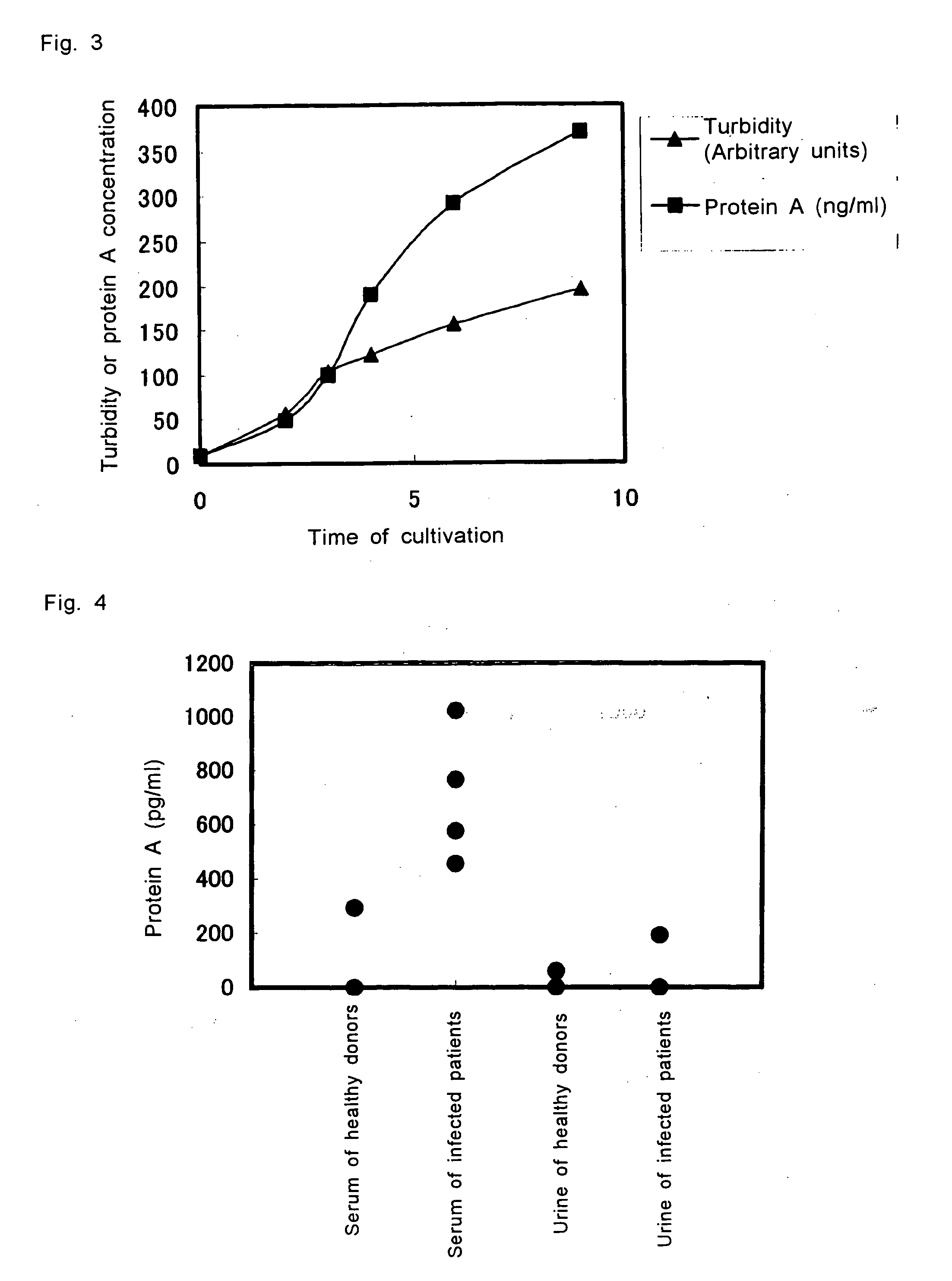Method of examing staphylococcus aureus
a staphylococcus and staphylococcus technology, applied in the field of staphylococcus aureus testing, can solve the problems of not being able to detect bacterium in a minute amount in blood, patients are often too serious to utilize the test, and the identification of bacterium is needed a long time, so as to achieve convenient and rapid testing, high sensitivity
- Summary
- Abstract
- Description
- Claims
- Application Information
AI Technical Summary
Benefits of technology
Problems solved by technology
Method used
Image
Examples
example 1
(1) Preparation of a Plate Having Primary Antibody Immobilized Thereto
[0044] Mouse IgG 1 anti-protein A monoclonal antibody diluted with 25 mM phosphate buffer solution (PBS) containing 150 mM NaCl to 10 μg / mL was dispensed in the wells of a plate at 50 μL / well, and the plate was allowed to stand overnight at 4° C. for immobilization of the antibody. The content was removed from the plate the next day, and after adding 280 μL / well of BlockAce (manufactured by Dainippon Pharmaceutical) diluted to 4 folds with purified water, the plate was allowed to stand overnight or longer at 4° C. In use, the plate washed three times with PBS containing 0.05% Tween20 (PBS-T) was used for the reaction.
(2) Preparation of Biotinylated Secondary Antibody
[0045] 500 μL (1 mg / mL) of goat anti-protein A antibody F(ab!)2 obtained by digesting goat anti-protein A polyclonal antibody with pepsin was dialyzed against 0.1M sodium hydrogen carbonate. A solution of 0.05 mg of Sulfo-NHS-LC-Biotin (manufactur...
example 2
(1) Measurement of Protein A by Sandwich Enzyme Immunoassay (1)
[0046] 50 μL / well of purified protein A diluted with diluted BlockAce (BlockAce diluted to 10 folds with purified water) to 0.5, 1, 5, 10, and 50 ng / mL was added to the wells of the microtiter plate having the mouse IgG 1 anti-protein A monoclonal antibody immobilized thereto produced in Example 1(1). After allowing the reaction to take place overnight at 4° C., the wells were washed with PBS-T, and 50 μL / well of biotinylated secondary antibody of Example 1 diluted with diluted BlockAce to 2.9 μg / mL was added. The reaction was then allowed to proceed at room temperature for 1 hour, and the wells were washed with PBS-T. In the meanwhile, avidinated HRP (manufactured by Zymed) was diluted with 0.2% BSA-PBS to 4000 folds, and 50 μL / well of this dilution was added to the well, and the reaction was allowed to proceed at room temperature for 1 hour. After washing, 50 μL / well of 0.1M citrate buffer solution, containing 2 mg / m...
example 3
Measurement of the Amount of Protein A in the Culture Supernatant Over Time
[0050] To 10 mL of heart-infusion broth was added 80 μL of overnight culture of the clinically isolated strain of S. aureus (MRSA1932), and the cultivation was continued. 1 mL portion of the culture was collected over time, and the collected culture was centrifuged for 2 minutes. The supernatant was filtered with 0.2 μm membrane, and the filtrate was stored at −30° C. until measurement. In order to measure the amount of the protein A secreted in accordance with the growth of the bacterium, the sample was diluted 25 to 200 folds with diluted BlockAce for measurement by ELISA. The results are shown in FIG. 3.
[0051] As demonstrated by the results, production of protein A increased corresponding to with the growth phase of the bacterium, namely, at a faster rate in the logarithmic phase compared to the stationary phase.
PUM
| Property | Measurement | Unit |
|---|---|---|
| temperature | aaaaa | aaaaa |
| wavelength | aaaaa | aaaaa |
| concentration | aaaaa | aaaaa |
Abstract
Description
Claims
Application Information
 Login to View More
Login to View More - R&D
- Intellectual Property
- Life Sciences
- Materials
- Tech Scout
- Unparalleled Data Quality
- Higher Quality Content
- 60% Fewer Hallucinations
Browse by: Latest US Patents, China's latest patents, Technical Efficacy Thesaurus, Application Domain, Technology Topic, Popular Technical Reports.
© 2025 PatSnap. All rights reserved.Legal|Privacy policy|Modern Slavery Act Transparency Statement|Sitemap|About US| Contact US: help@patsnap.com


